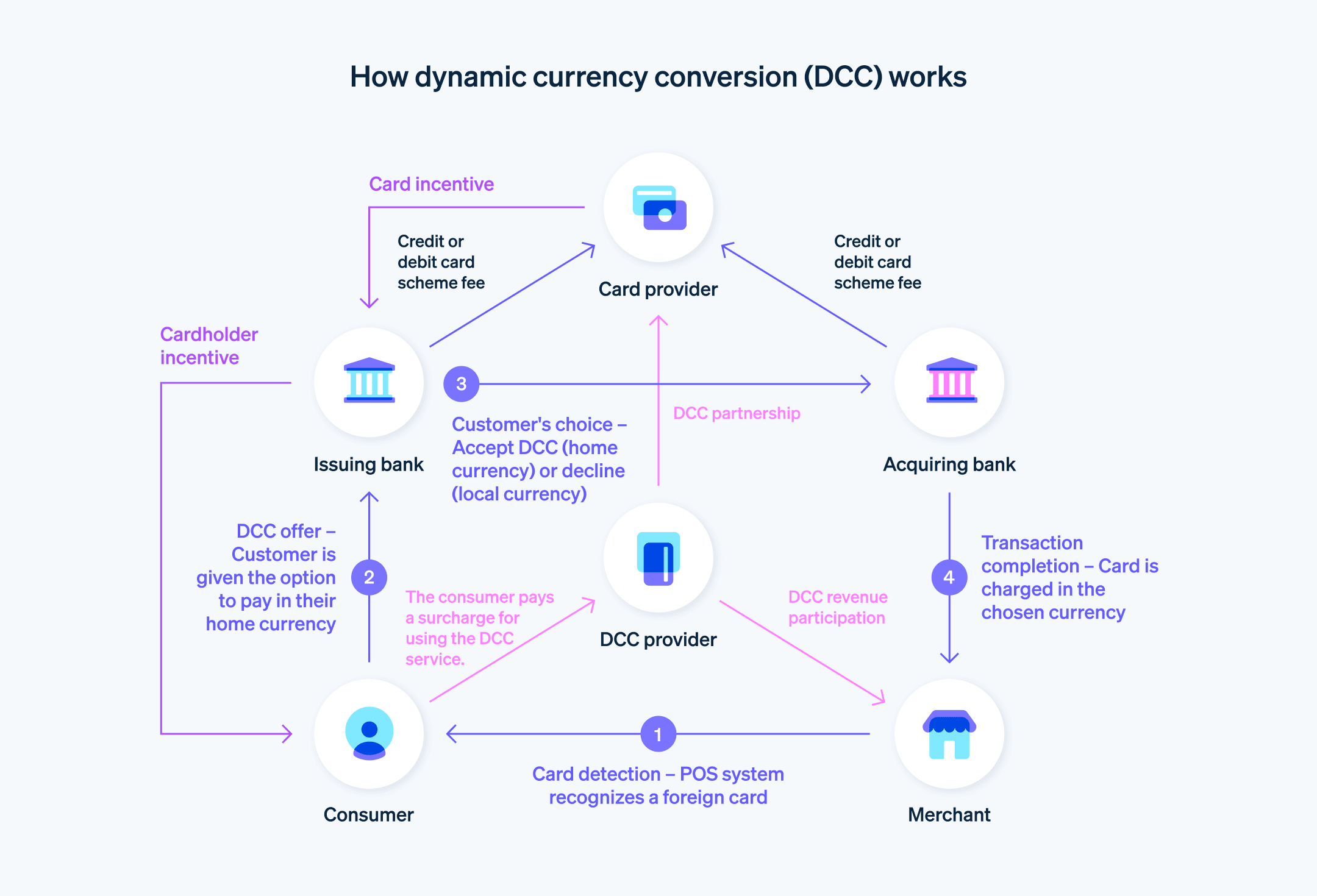動的通貨換算 (DCC) とは金融サービスの一種で、ある国の購入者が別の国でクレジットカードまたはデビットカードによる購入を行った際の国際取引で使われます。DDC により、販売時にカード保有者の自国通貨で取引を処理できるようになります。世界のクレジットカード決済市場は、2022 年には 5,249 億ドルでしたが、2032 年までに 1 兆 2,000 億ドルに急成長すると予測されています。この成長の重要部分を占めるのはクロスボーダー決済です。
この記事では、動的通貨換算の仕組み、従来の通貨換算との比較、動的通貨換算を導入するメリットとデメリットなど、動的通貨換算について企業が知っておくべきことをご説明します。
この記事の内容
- 動的通貨換算の仕組み
- 動的通貨換算と従来の通貨換算の比較
- 企業が動的通貨換算を使用するメリット
- 動的通貨換算が抱える課題
- 動的通貨換算に関するベストプラクティス
- Stripe で動的通貨換算を利用できるか
動的通貨換算の仕組み
DCC を利用すると、カード保有者が取引コストを自国通貨ですぐ簡単に把握できます。ただし、為替レートのマークアップや手数料により、コストが高くなる可能性があります。DCC により、企業と金融機関は収入の上昇を実現できる可能性があります。DCC の仕組みを以下にご説明します。
DCC のプロセス
カードの検出: 企業の POS システムや E コマースプラットフォームで顧客が外国のクレジットカードまたはデビットカードを使用すると、システムがカードの発行国を判定します。
DCC オファー: 企業のシステムが DCC テクノロジーを搭載している場合、カード保有者に対し、自国通貨で取引を行うオプションが自動的に提示されます。その場合、為替レートと通貨換算に伴う追加手数料を加算した金額が表示されます。
顧客の選択: カード保有者は DCC オファーを承諾して自国通貨で支払いを行うか、これを拒否して現地通貨で支払いを行います。
取引の完了: 顧客が DCC を選択すると取引が処理され、表示された為替レートにより、カード保有者の自国通貨でカードへの請求が行われます。カード保有者が DCC を拒否した場合、取引が現地通貨で処理され、カード保有者の銀行がその銀行の為替レートで換算を行います。
役割とメリット
企業: 企業にとっては、通貨換算プロセスに伴う報酬や手数料によって収入を増やせるというメリットがあります。
金融機関: DCC を提供する銀行や金融サービスプロバイダーは為替レートと手数料を設定します。多くの場合、この為替レートは標準の為替レートにマークアップを追加したものです。
技術連携
決済処理テクノロジー: DCC のテクノロジーにより、外国カードの自動検出とリアルタイムの通貨換算が可能になり、POS システムやオンラインで DCC を簡単に利用できるようになります。
POS システムや E コマースとの連携: DCC は最新の POS システム やオンラインペイメントゲートウェイを連携できるため、企業は店舗やオンラインで全世界の顧客に商品・サービスを販売できるようになります。
たとえば、アメリカ人旅行者がイタリアで 100 ユーロの商品を購入する場合を考えてみましょう。POS システムがアメリカのクレジットカードであると判別し、120 ドル (DCC の為替レートと手数料込み) の請求を表示します。旅行者は、自国通貨での正確なコストを把握したうえで 120 ドルを支払うか、100 ユーロを支払って通貨換算を銀行に任せるかを選択できます。

動的通貨換算と従来の通貨換算の比較
動的通貨換算と従来の通貨換算はどちらも国際カード取引で使われますが、異なる方法です。それぞれ為替レート、手数料、顧客の選択、企業のメリットの扱いが異なります。両者の違いを以下にご説明します。
為替レートと手数料の違い
動的通貨換算
為替レート: 多くの場合、DCC の為替レートは毎日の銀行為替レートにマークアップを追加したものです。このマークアップには、通貨換算手数料と企業または DCC プロバイダーの利益が含まれます。
手数料: 通常、DCC 取引には追加手数料がかかります。追加手数料は顧客に提示される為替レートに加えられています。追加手数料の金額は企業や DCC サービスプロバイダーによって異なる場合があります。
従来の通貨換算
為替レート: 従来の通貨換算の場合、取引が処理された後で顧客の銀行やカード発行会社が為替レートを決定します。通常、これは銀行間の為替レートに近いレートになります。そのため、従来の通貨換算の方が顧客にとって有利になる傾向があります。
手数料: 従来の通貨換算の場合、顧客の銀行の外国取引手数料がかかることがあります。外国取引手数料は取引金額の一定割合であることが多く、為替レートとは別に発生します。
顧客の選択と顧客体験への影響
動的通貨換算
即時の明確化: DCC を利用すると、カード保有者の自国通貨で取引コストをすぐに把握できます。これは、将来的な為替レートの変動を気にすることなく前もって正確なコストを把握しておきたいユーザーにとって特に魅力できます。
コスト上昇の可能性: 為替レートが高く、手数料もかかるため、従来の通貨換算よりも顧客の支払い額が高くなる可能性があります。2017 年に行われた欧州消費者機構の研究によると、ヨーロッパで DCC を利用した顧客は 2.6 ~ 12% 多く支払っています。この結果から、DCC を使わないように勧められることが多い理由が分かります。
従来の通貨換算
コスト削減の可能性: 動的通貨換算よりも顧客に有利な為替レートが設定され、手数料の総額が低くなる可能性があるため、顧客にとってコスト削減になる可能性があります。
コストの不透明さ: 自国通貨での正確なコストが購入時は不明なうえ、将来的な為替レートの変動や銀行手数料に左右されます。
企業側のメリットとデメリット
企業にとっての DCC のメリット
収入の上昇: 企業は DCC 取引によって報酬や手数料を獲得できるため、新たな収益源を創出できます。
顧客の利便性: DCC に対応すると、顧客が選択できる支払い方法が増え、顧客の自国通貨での金額が明確になるため、顧客の買い物体験を向上させることができます。
企業にとっての DCC のデメリット
導入と法令遵守: DCC を利用するには決済システムとの連携と各種の国際規制への準拠が必要になるため、企業に負担やコストがかかる可能性があります。
顧客の印象: 為替レートや手数料の高さから過度な金額を請求されていると感じる顧客は DCC に批判的な印象を抱く可能性があります。
従来の通貨換算のメリットとデメリット
シンプル: 企業の側からすると、DCC システムの連携が不要なため、従来の通貨換算の方が簡単に対応できます。
収入機会の減少: 従来の通貨換算には、DCC のような通貨換算手数料による追加収入がありません。
DCC の場合、顧客の自国通貨での金額がその場で表示できる一方で、多くの場合、為替レートのマークアップや伴う手数料のためにコストが高くなります。顧客にとって従来の通貨換算の方がコストパフォーマンスに優れるかもしれませんが、DCC のように前もって金額を知ることができません。DCC は企業に新たな収益源をもたらすとともに、顧客の利便性を高めることができます。その一方で、DCC の導入には手間がかかるうえ、コストが高いという印象から顧客の反感を買う可能性があります。
企業が動的通貨換算を使用するメリット
DCC には、顧客の利便性の向上や収入の増加など、全世界で販売を行っている企業にとって多くのメリットがあります。DCC のメリットを以下にご説明します。
海外の買い物客の利便性
簡単な取引: DCC によって顧客の自国通貨での価格表示と支払いが可能になるため、海外顧客の購入プロセスがシンプルになります。これにより、頭の中で通貨換算を行う必要がなくなり、買い物体験がより直感的になります。
親しみと安心: 普段使っている通貨で支払いを行えるため、特に通貨の違いで購入が複雑になる国際取引では、顧客に安心感を与えることができます。
コストの即時確認: DCC を利用すると顧客は購入時に自国通貨での正確なコストを把握できます。それにより、為替レートの変動や銀行によって請求される可能性がある未知の手数料に伴う不透明さを排除できます。
通貨為替レートの透明性
為替レート情報の事前確認: DCC を利用する場合、取引時に為替レートが顧客に通知されるため、通貨換算に用いられるレートが明確になります。
情報に基づく判断: 為替レートを事前に把握できるため、DCC を利用して購入するか、銀行を経由する標準的な通貨換算プロセスを用いるかどうか、十分な情報を得たうえで判断できます。
隠れた手数料の回避: DCC のレートにはマークアップが加えられている可能性があるものの、取引の全体像は明確にされています。銀行での通貨換算では隠れた手数料が発生することがありますが、DCC の場合はその心配がありません。
企業が得られる可能性がある報酬とメリット
新たな収益源の創出: 企業は、DCC、換算手数料の配分、為替レートへのマークアップの追加によって収入を高めることができます。
顧客へのサービスの向上: DCC は総合的な顧客体験を強化する付加価値サービスと捉えることができます。DCC は、観光、ホスピタリティー、E コマースなど、国際取引が日常的に行われている業界で特にメリットがあります。
競争上の優位性: DCC に対応することで、企業は DCC に対応していない競合他社と差別化を図ることができます。その結果、海外顧客への訴求力が高まる可能性があります。
会計の効率化: 企業の側では、取引を自国通貨で処理すると海外売上を現地通貨に換算する必要がなくなるため、会計と財務報告がシンプルになります。
動的通貨換算が抱える課題
動的通貨換算には複数のメリットがあるものの、顧客の側にも企業の側にも課題が伴います。DCC の導入を検討している企業が知っておくべき課題を以下にご説明します。
顧客側のコスト上昇
不利な為替レート: 多くの場合、DCC では標準的な銀行レートよりも不利な為替レートが設定されます。このマークアップによって顧客側のコストが上昇し、現地通貨で処理する場合よりも購入額が高くなる可能性があります。
認識の不足: DCC に伴う追加コストについて顧客が完全に把握していない可能性があります。銀行を介して通貨換算を行う場合よりもコストが高くなる可能性があることを知らずに、顧客が DCC を利用する可能性があります。
透明性と同意に関する懸念
情報提供の不足: DCC の利用規約 (為替レートや手数料など) を顧客に明確に伝えていない場合があります。その場合、混乱を引き起こしたり、顧客が不満を抱いたりする可能性があります。
同意に関する問題: まれな事例ですが、顧客に無断で DCC を勝手に利用させることがあります。これは非倫理的とみなされます。顧客本人が従来の通貨換算ではなく DCC を選択した場合に限り、DCC を用いて取引を処理する必要があります。
規制と法令遵守の要件
複雑な規制: 企業が DCC に対応するには複雑な国際金融規制を把握して遵守しなければならず、そのために多くのリソースが必要になる可能性があります。
継続的なモニタリング: 為替レートは絶えず変動するため、企業が競争力と公正さを維持するには、DCC のレートを継続的にモニタリングし、調整する必要があります。
顧客の印象への影響
顧客体験の低下: 顧客が DCC によって騙されたと感じたり、過剰に請求されたと感じたりした場合、企業に対して否定的な印象を持つ可能性があり、顧客ロイヤルティやブランドの評判が低下する可能性があります。
情報提供の必要性: DCC を利用する企業には、従業員や顧客への十分な情報提供を行うことが求められます。誤解を招いたり、誤った情報を伝えたりすると、顧客体験が低下する可能性があります。
技術的な課題と運用上の課題
POS システムとの連携: DCC を導入するには POS システムとの連携が必要ですが、難しい場合やコストがかかる場合があります。
通貨管理: 企業には複数の通貨を効率的に管理することが求められますが、会計業務や財務管理が複雑になる可能性があります。
市場の変化
- 観光や国際貿易への依存: DCC に大きく依存する企業の場合、海外旅行が減少する時期や貿易が変動する時期に苦しくなる可能性があります。
動的通貨換算に関するベストプラクティス
理解と法令遵守
規制遵守: 通貨換算と金融取引に関するすべての現地規制と国際規制を遵守する必要があります。
教育: DCC の仕組み、企業や顧客にとっての DCC のメリットや影響など、DCC について従業員に十分に理解させる必要があります。
顧客への明確な情報提供
情報に基づく選択: 必ず、自国通貨と現地通貨のどちらで支払うかを顧客自身に選ばせてください。指定がない場合の支払い方法として、DCC を無断で使用することは避けてください。
明確な説明: DCC の詳細と取引に与える影響について簡潔に明確に説明します。
レートの表示: 為替レートと関連手数料を前もって表示します。
競争力のある公正な価格設定
公正な為替レート: 競争力のある為替レートを使用します。過剰に請求を行うと、顧客満足度や企業の評判が低下する可能性があります。
料金体系: 妥当で、競争力のある料金体系を維持します。料金が適正範囲を超える場合、顧客が離れる可能性があります。
テクノロジーと連携
スムーズな連携: 取引プロセスの遅延や複雑化を招くことなく、DCC を自社の決済システムと連携できることを確認してください。
セキュリティ: 取引データを保護するためのセキュリティ対策を導入し、PCI データセキュリティ基準 (PCI DSS) などの基準に準拠します。
モニタリングと分析
取引のモニタリング: DCC 取引を定期的にモニタリングして、エラーや不正利用が疑われる異常なアクティビティやパターンを検出します。
パフォーマンス分析: 自社における DCC のパフォーマンスを分析します。顧客への普及状況、生み出した収入、顧客のフィードバックに注目します。
顧客のサポートとフィードバック
サポート体制: カスタマーサポートを設けて、通貨換算に関する問い合わせを簡単に行えるようにします。
フィードバック機構: DCC に関する顧客体験など、顧客のフィードバックを収集して分析する仕組みを整えます。
マーケティングとプロモーション
標的を絞ったマーケティング: 標的を絞ったマーケティングの実施を検討します。特定地域を対象に DCC のメリットを周知します。
プロモーションオファー: 初回利用者や特定期間中の割引など、DCC のプロモーションオファーを実施します。
継続的な改善
最新情報の入手: 為替市場、テクノロジー、規制の変化を注視します。
調整と進化: 新テクノロジー、顧客の好み、市場動向に基づいて DCC の取り組みを調整できるようにしておきます。
パートナーシップ
適切なパートナーの選定: DCC に関連してサードパーティーサービスを使用する場合、透明性と公正さに定評があり、信頼できるプロバイダーを選びます。
規約の交渉: プロバイダーと交渉し、企業にとって好ましく、顧客にとって公正な規約に合意します。
Stripe で動的通貨換算を利用できるか
Stripe は動的通貨換算に対応していませんが、アメリカ、カナダ、グレートブリテン、ユーロ圏で事業を行う企業向けに自動通貨換算機能を提供しています。自動通貨換算機能を利用すると、Stripe が提示する最新の為替レートを用いて、顧客の現地通貨で金額を表示できるようになります。自動通貨換算機能の仕組みを以下にご説明します。
40 種類以上の通貨に対応する通貨換算: この機能を利用すると、金額を 40 カ国以上の現地通貨に換算できます。顧客の現地通貨で金額を表示できるようになり、顧客体験が向上するほか、現地通貨の提示を要する決済手段への対応が可能になります。
顧客による通貨選択: 金額を自国通貨で表示するか、企業が設定した元の通貨で表示するかを顧客が選択できます。この柔軟性によって海外顧客のさまざまな好みに対応できるため、顧客は自分にとって最も使い勝手のいい通貨を選択することが可能です。
手数料と為替レート: Stripe は中間市場為替レートを適用しており、Checkout のセッションから売上処理までの間そのレートを保証するためのマージンを追加しています。自動通貨換算の標準的な取引手数料には以下のようなものがあります。
- カードまたは決済手段の手数料
- 国際カードまたは決済手段の手数料 (該当する場合)
- 通貨換算の手数料
- カードまたは決済手段の手数料
保証為替レート: 為替レートの変動率が 2% を超えない限り、為替レートは Checkout や Payment Links のセッションが開始されてから売上処理が完了するまで保証されます。為替レートが 2% を超えて変動した場合、取引の売上処理の際に最新の為替レートが適用される可能性があります。この保証により、企業と顧客にとって金額の安定性を保つことができます。
返金やチャージバックの処理: 顧客が支払いに使用した通貨で返金やチャージバックが行われます。ただし、自動通貨換算では、返金やチャージバックに同じ為替レートが適用されることが保証されません。返金やチャージバックが行われる時点の Stripe が提示する為替レートが適用されます。そのため、為替レートの変動によっては企業に利益や損失が発生する可能性があります。
Stripe の自動通貨換算機能は、海外顧客への対応を目指す企業にとって柔軟性の高いソリューションとなります。自動通貨換算機能を利用することで、通貨換算プロセスをシンプルにし、価格設定の透明性を確保し、保証為替レートなどの安全対策を追加することができます。ただし、追加手数料がかかる場合があるうえ、企業は返金やチャージバックを注意して取り扱う必要があります。Stripe の Adaptive Pricing についてもっと知る。
この記事の内容は、一般的な情報および教育のみを目的としており、法律上または税務上のアドバイスとして解釈されるべきではありません。Stripe は、記事内の情報の正確性、完全性、妥当性、または最新性を保証または請け合うものではありません。特定の状況については、管轄区域で活動する資格のある有能な弁護士または会計士に助言を求める必要があります。